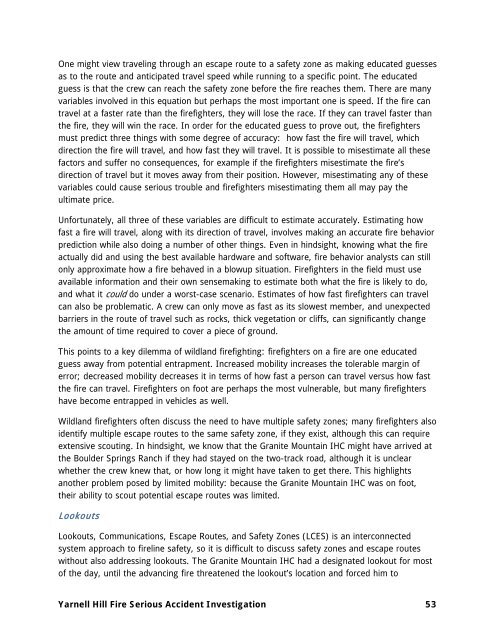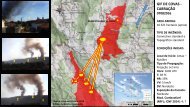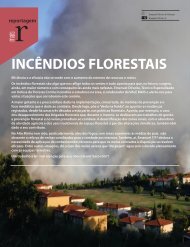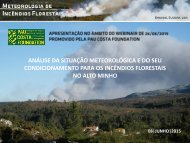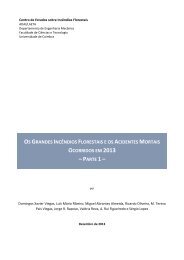Relatório do Acidente ocorrido no Incêndio Florestal de Yarnel Hill
Neste incêndio, de 30 de Junho de 2013, morreram 19 combatentes florestais da equipa "Hot Shot" de Granite Mountain.
Neste incêndio, de 30 de Junho de 2013, morreram 19 combatentes florestais da equipa "Hot Shot" de Granite Mountain.
Create successful ePaper yourself
Turn your PDF publications into a flip-book with our unique Google optimized e-Paper software.
One might view traveling through an escape route to a safety zone as making educated guesses<br />
as to the route and anticipated travel speed while running to a specific point. The educated<br />
guess is that the crew can reach the safety zone before the fire reaches them. There are many<br />
variables involved in this equation but perhaps the most important one is speed. If the fire can<br />
travel at a faster rate than the firefighters, they will lose the race. If they can travel faster than<br />
the fire, they will win the race. In or<strong>de</strong>r for the educated guess to prove out, the firefighters<br />
must predict three things with some <strong>de</strong>gree of accuracy: how fast the fire will travel, which<br />
direction the fire will travel, and how fast they will travel. It is possible to misestimate all these<br />
factors and suffer <strong>no</strong> consequences, for example if the firefighters misestimate the fire’s<br />
direction of travel but it moves away from their position. However, misestimating any of these<br />
variables could cause serious trouble and firefighters misestimating them all may pay the<br />
ultimate price.<br />
Unfortunately, all three of these variables are difficult to estimate accurately. Estimating how<br />
fast a fire will travel, along with its direction of travel, involves making an accurate fire behavior<br />
prediction while also <strong>do</strong>ing a number of other things. Even in hindsight, k<strong>no</strong>wing what the fire<br />
actually did and using the best available hardware and software, fire behavior analysts can still<br />
only approximate how a fire behaved in a blowup situation. Firefighters in the field must use<br />
available information and their own sensemaking to estimate both what the fire is likely to <strong>do</strong>,<br />
and what it could <strong>do</strong> un<strong>de</strong>r a worst-case scenario. Estimates of how fast firefighters can travel<br />
can also be problematic. A crew can only move as fast as its slowest member, and unexpected<br />
barriers in the route of travel such as rocks, thick vegetation or cliffs, can significantly change<br />
the amount of time required to cover a piece of ground.<br />
This points to a key dilemma of wildland firefighting: firefighters on a fire are one educated<br />
guess away from potential entrapment. Increased mobility increases the tolerable margin of<br />
error; <strong>de</strong>creased mobility <strong>de</strong>creases it in terms of how fast a person can travel versus how fast<br />
the fire can travel. Firefighters on foot are perhaps the most vulnerable, but many firefighters<br />
have become entrapped in vehicles as well.<br />
Wildland firefighters often discuss the need to have multiple safety zones; many firefighters also<br />
i<strong>de</strong>ntify multiple escape routes to the same safety zone, if they exist, although this can require<br />
extensive scouting. In hindsight, we k<strong>no</strong>w that the Granite Mountain IHC might have arrived at<br />
the Boul<strong>de</strong>r Springs Ranch if they had stayed on the two-track road, although it is unclear<br />
whether the crew knew that, or how long it might have taken to get there. This highlights<br />
a<strong>no</strong>ther problem posed by limited mobility: because the Granite Mountain IHC was on foot,<br />
their ability to scout potential escape routes was limited.<br />
Lookouts<br />
Lookouts, Communications, Escape Routes, and Safety Zones (LCES) is an interconnected<br />
system approach to fireline safety, so it is difficult to discuss safety zones and escape routes<br />
without also addressing lookouts. The Granite Mountain IHC had a <strong>de</strong>signated lookout for most<br />
of the day, until the advancing fire threatened the lookout’s location and forced him to<br />
<strong>Yarnel</strong>l <strong>Hill</strong> Fire Serious Acci<strong>de</strong>nt Investigation 53


